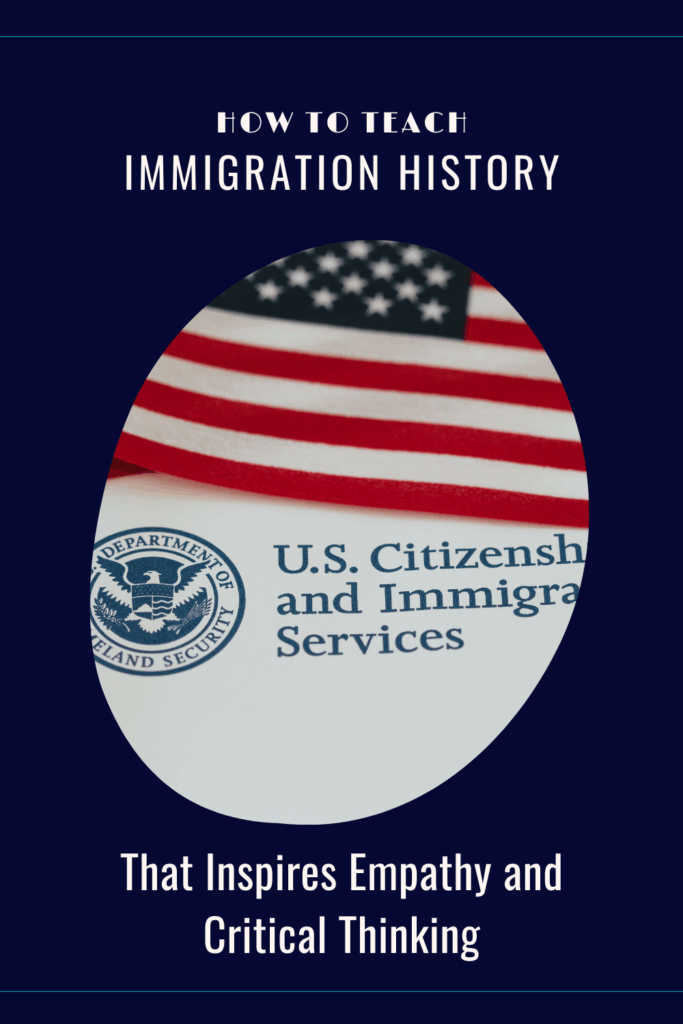When I first started teaching U.S. History, I’ll admit, my lessons on immigration felt flat. The textbook did its predictable thing: talk about Ellis Island, throw in a couple photos of immigrant families, then move on to nativism and the quota system.
Done.
But here’s the problem. Immigration is not just “a unit.” It’s a living, breathing issue that still shapes our country today. And my students, many of them immigrants or the children of immigrants, deserve better than the sanitized version. They deserve compassion. They deserve to see immigration as more than Ellis Island trivia.
So, I’ve rethought how I teach “New Immigration” (late 1800s–early 1900s). Instead of focusing only on policies and stereotypes, I make space for empathy, critical thinking, and connections to today. That means I don’t shy away from controversial issues, but I approach them with care.

Here’s how I structure it.
Start with an Attitude Inventory
Before diving into the past, I want to know where my students stand today. I give them an attitude inventory with statements like:
- The U.S. should make it easier for immigrants to become citizens.
- Immigrants take jobs away from American-born workers.
- Immigrants strengthen American culture.
Students mark whether they agree, disagree, or are unsure.
Then we discuss. I’m not looking for right or wrong answers, I’m looking for students to recognize that they already have opinions, and that history will give them more context.
But you have to be careful.
A former colleague of mine borrowed my inventory, and it backfired. Make sure you know your students and the dynamics of your class. You want to laydown the groundwork for how students should behave during discussion. When in doubt, turn this group activity into an independent one. That way, only you see their responses.
Related: Ultimate Social Studies Bundle – FREE
The Groups and Where They Went
We can’t just lump “immigrants” into one big group. Between 1880 and 1920, millions came from Italy, Poland, Russia, Greece, China, Japan, Mexico, and more. Each group had specific reasons for leaving home and specific destinations once they arrived.
Lesson idea: Students analyze census maps showing immigrant settlement patterns (Italians in NYC, Poles in Chicago, Scandinavians in the Midwest). Then they create a short narrative: “If I immigrated to the U.S. in 1900, where would I likely live and why?”
Push and Pull Factors
Why did people leave their homelands? Why did they come here? Famine, persecution, and lack of opportunity pushed people out. Jobs, safety, and freedom pulled them in.
Lesson idea: Have students sort primary sources (letters, newspaper ads, political cartoons) into “push” and “pull” categories. Then debate: Which was stronger, the push or the pull?
Nativism
If you think anti-immigrant sentiment is new, it’s not. The rise of nativism in the late 1800s sounds eerily familiar today: “Immigrants don’t assimilate.” “They’re taking our jobs.” “They’re dangerous.”
Lesson ideas:
- Compare two political cartoons—one from the 1890s and one from today. Students identify common stereotypes and discuss what has (or hasn’t) changed.
- Stations Activity
- My essential question is: How has nativism impacted immigrants since the turn of the 20th century?
- I have the following stations in my Nativism Stations Activity:
- Political Cartoon Analysis
- Chinese Immigration
- Irish Immigration
- Italian Immigration
- Modern Immigration
RELATED: Make Social Studies Discussions Work For Even The Most Reluctant Students
The Chinese Exclusion Act
This is the first major federal law banning immigration based on race and nationality. That alone makes it worth slowing down and unpacking.
Lesson ideas:
- Students read short excerpts from the Act alongside quotes from Chinese immigrants. Then they write a journal entry from the perspective of someone facing exclusion.
- There’s also a great documentary from American Experience about it.
Positive Impact of New Immigration
Immigrants weren’t just “cheap labor.” They built communities, started businesses, created culture, and shaped the nation. Without them, there is no modern America.
Lesson idea: Students research one immigrant group’s cultural contributions (food, art, labor, music, politics) and present it in a gallery walk.
Three More Topics You Shouldn’t Skip
- Ellis Island vs. Angel Island
Not all entry points were the same. Ellis Island processed European immigrants quickly; Angel Island often detained Asian immigrants for weeks or months. The contrast shows how racism shaped immigration policy.
- Lesson idea: Give students two immigrant narratives, one from Ellis Island, one from Angel Island. Ask: How does geography intersect with race in the immigration experience?
- Tenement Life
Textbooks love to show Jacob Riis’s How the Other Half Lives, but we can do more than gawk at poverty. Students should understand the resilience and community that developed in immigrant neighborhoods, too.
- Lesson idea: Do a “then and now” photo analysis of tenements vs. modern immigrant neighborhoods.
- Have students write: What struggles remain? What strengths endure?
- Have students write: What struggles remain? What strengths endure?
- Immigrant Labor and Labor Movements
Immigrants didn’t just work, they organized. From coal miners to garment workers, immigrants fought for labor rights that benefit all workers today.
- Lesson idea: Have students analyze primary sources from the Lawrence Textile Strike or Triangle Shirtwaist Fire.
- Then ask: How did immigrant laborers transform American work?
- Then ask: How did immigrant laborers transform American work?
Why This Matters
When we teach immigration only as numbers and policies, we strip away humanity. But when we teach it compassionately, acknowledging the struggles, the resilience, and the voices of immigrants themselves, we prepare our students to think critically about immigration today.
After all, this isn’t just history. It’s living history. And our students are part of it.
Don’t forget! Ultimate Social Studies Bundle – FREE
+ show Comments
- Hide Comments
add a comment